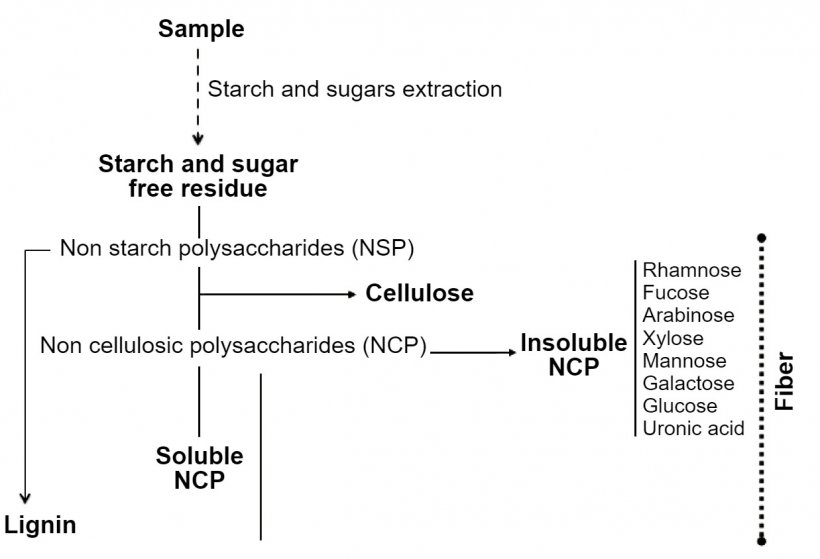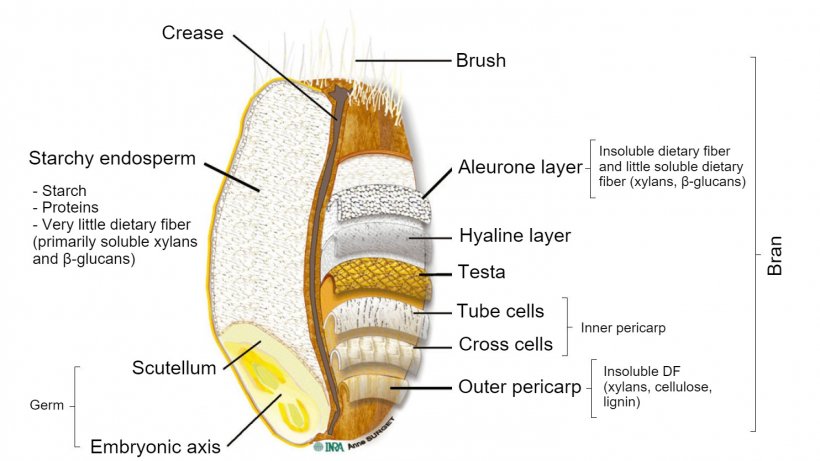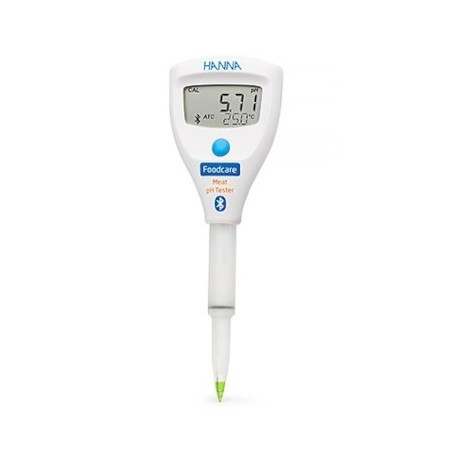Xylanases are a group of enzymes with carbohydrase activity, specifically classified as glycosidase, that hydrolyse the polysaccharide xylan transforming it into a xylose.
Xylanase is common in bacteria and yeasts that degrade plant material. These organisms will be used for the production of the enzyme that will be used in feed production.

The substrate of xylanases
Xylose is found in arabinoxylans, a polymer found in hemicellulose that is part of the non-starch polysaccharides (NSP) group, with a variable arabinose:xylose ratio. Figure 1 outlines the determination of NSP.

Figure 1. Determination of nonstarch polysaccharides, lignin, and fiber by enzymatic-chemical procedure. Knudsen (2014)
The cell wall that coats the endosperm of the cereals commonly used in the swine feed industry is made of NSP (Figure 2).

Figure 2. Cross-section of a whole wheat kernel grain with location of specific compounds. Adapted by Knudsen (2014) from Surget and Barron (2005).
Arabinoxylans are the main non-cellulosic polysaccharides found in cereals like wheat, barley or rye, the latter being less used in pig diets.
Chemical structure and physical properties of arabinoxylans
Arabinoxylans contain linear chains of xylose units connected through β-(1-4) bonds, with several branches of β-L-arabinofuranose units (Figure 3).

Figure 3. Chemical structure of arabinoxylans. The arabinose branches and their distribution vary depending on the cereals and between varieties of a cereal.
Arabinoxylans can be classified as soluble or insoluble, and the degree of solubility will vary depending on the presence of arabinose in the carbohydrates chain. Arabinose gives a greater complexity to the structure, conditioning the ability to interact with other molecules, the solubility and the sensitivity to enzymatic hydrolysis. The hydrolysis will depend on the arabinose distribution pattern, that is very variable. These patterns differ between cereals, but also between the varieties of the same cereal.
In the case of cereals like wheat and rye, soluble arabinoxylan (approximately 30% of the total) is what promotes a “viscous” nature of the intestinal contents. This viscosity effect can have a negative influence on the gut microbiota.
When comparing the different ingredients normally used in pig diets we see that corn and soybean meal promote less viscous intestinal contents than rye, barley, oats or wheat.
The arabinoxylan of corn is characterized for its branching with L-arabinose, glucuronic acid and ferulic acid. In the stomach, under acid pH conditions, L-arabinose allows the partial release of arabinoxylans. On the other hand, soybean meal contains xylose as xyloglucans, and soy bean contains xylose that is basically related to the contents in xylanes of the hull.

Arabinoxylanos in raw materials
The contents in total non-starch polysaccharides, total arabinoxylans, and their respective soluble fractions of different raw materials can be seen in Table 1.
Table1. Contents in total NSP, total arabinoxylans (DM %) and their respective soluble fractions (% of the total).
| Ingredient | Total NSP | Soluble NSP |
Toral arabinoxylans |
Soluble arabinoxylans |
|---|---|---|---|---|
| Wheat | 11.4 | 21.7 | 7.1 | 23.6 |
| Barley | 17.4 | 26.1 | 7.9 | 11.1 |
| Rye | 14.0 | 25.6 | 8.9 | 34.9 |
| Triticale | 14.7 | 22.7 | 9.7 | 12.0 |
| Sorghum | 5.1 | 11.4 | 2.3 | 4.8 |
| Corn | 8.8 | 11.8 | 4.6 | 5.0 |
| Wheat bran | 35.3 | 1.3 | 19.8 | 6.3 |
| Maize DDGS | 20.6 | 1.3 | 12.7 | 9.3 |
| Rapeseed meal | 22 | 15.5 | 6.3 | 25.4 |
| Sunflower meal | 31.2 | 11.3 | 8.5 | 13.0 |
| Soybean meal | 21 | 27.6 | 4.1 | 24.1 |
| Peas | 17.4 | 28.9 | 4.9 | 44.9 |
| Lupins | 46.1 | 44.3 | 4.3 | 65.1 |
Average values obtained based on Englyst (1989), Choct, M. (1997), Bach Knudsen, K. E. (2010 and 2014) and own data.
Kinds of xylanases and their characteristics
There are many kinds of xylanases, and the structure, functioning and optimal characteristics for showing the highest enzymatic activity are quite different between them.
Endo-β-(1,4)-D-xylanases, known as xylanases, are the main enzymes involved in the degradation of arabinoxylan. They divide arabinoxylans by internally hydrolysing the 1,4-β-D-xylosidic bond between xylose residues randomly in the xylan structure. In 2007, more than 290 xylanases were identified, and they were grouped in six different glycoside hydrolase (GH) families (5, 7, 8, 10, 11 and 43) (Collins et al., 2005; Dornez et al., 2009). The degradation pattern of each of these enzymes can be different, giving place to different enzymatic products. For instance, most of the glycoside hydrolases classified in the GH 10 family are the endo-β-1,4-xylanases that degrade the arabinoxylane with a high arabinose replacement ratio in smaller fragments. These residual oligosaccharide fractions may be greatly interesting as a readily available substrate for its fermentation, acting as an energy donor or prebiotic functionality. GH 11 xylanases act preferably in the non-replaced regions in the structure, and for a correct hydrolysis they need three consecutive xyloses without arabinose radicals in between. Therefore, GH11 xylanases have a low activity on heteroxylanes with a high replacement ratio.
Therefore, xylanases, like any other enzyme, are specific for the substrate they need to act on. This means that for the enzyme to provide a benefit in the formulation of pig diets, the diet must contain the relevant specific substrate so the enzyme works: this is, arabinoxylans; and that the enzyme used contains the different kinds of xylanases established according to the previous classification, in accordance with the kind of substrate contained in the diet.
The characteristics of xylanases are determined by the kind of organisms that produce them (fungal or microbial). The xylanases commonly used in the feed industry are produced by Aspergillus niger, that is a yeast; and by Trichoderma reesei or Bacillus subtilis, that are bacteria. Among the different xylanase-producing strains, specific modifications have been made (selection and improvement of producing strains and genetically modified strains) for the improvement in the efficiency of production, performance and activity when the ancestral strains have been used by the xylanase production industry (in its different applications fields).
The optimal pH for bacterial xylanases is, in general, slightly higher than the optimal pH for fungal xylanases.
The enzymes can also differ regarding their thermal stability. Nevertheless, most of the enzymes currently commercialised are normally thermostable, retaining their activity even under conditioning temperatures. The liquid presentation and the post-granulation application through the spraying of the granules can be one of the best ways of retaining the maximum activity, avoiding the heat inactivation during the processing of feed.
The use of xylanases in diets
The hydration of arabinoxylans during the digestion process entails an increase in the luminal viscosity of the liquid or soluble phase that directly affects starch digestibility and that prevents the emulsion process of lipids, as well as the reabsorption process of bile acids before the ileocaecal valve. In this sense, the activity of xylanase can represent an opportunity for an important improvement on the digestibility of starch and fat, improving the use of energy, and indirectly promoting a decrease in the feed conversion ratio and feeding costs.
On the other hand, after the action of xylanase it produces a new residual substrate: oligosaccharide chains or structures that are potentially fermentable by the microbial population that is present beyond the terminal ileum and that will be able to give place to the production of short chain fatty acids (acetic, butyric and propionic). Acetate is basically used as a substrate for the production of butyrate. The butyrate produced is known for its functionality on gut health (source of energy for colonocytes) and the balance of the large intestines's microbiota. Propionate is metabolised in the liver, its is gluconeogenic and it inhibits lipogenesis.
Currently there are more than 20 products in the market that contain xylanase activity, whether alone or in combination with other enzymes, that have been approved by the European Union (EU) for their use in pig diets. Since the EU requires that enzyme suppliers prove the efficacy of their products in at least three scientific tests per animal species and production stage, there is a significant amount of data on this kind of enzymes in pig diets.
Recent findings
1. Investigation of xylanase, diet formulation method for energy, and choice of digestibility index marker on nutrient and energy utilization for broiler chickens and pigs.
Interactions were observed between xylanase supplementation and formulation method for energy for apparent ileal digestibility of dry matter, energy, Arg, and Lys. The inclusion of xylanase decreased the apparent ileal digestibility of Lys in diets containing diatomaceous earth or wheat bran, but increased apparent ileal digestibility of Arg in sand diet and apparent ileal digestibility of energy in wheat bran diet. The digestibility index marker type had no effect on responses in pigs.
2. Degradation of dietary fiber in the stomach, small intestine, and large intestine of growing pigs fed corn- or wheat-based diets without or with microbial xylanase.
Feed ingredients used in feed formulation and the concentration of dietary fiber may influence the degree of fermentation of fiber. The inclusion of xylanase A or B improved the apparent ileal digestibility and the apparent total tract digestibility of dietary fiber in wheat-based diets, indicating activity of xylanase in the gastro-intestinal tract of pigs. Inclusion of xylanase A improved the concentration of digestible energy and metabolizable energy in wheat-SBM-wheat middlings diets and xylanase B improved the concentration of DE in wheat-based diets and improved the concentration of the metabolizable energy in wheat-SBM diet. In conclusion, the xylanases used in this experiment improved the digestibility of dietary fiber in the stomach and hindgut and improved the energy status of pigs fed wheat-based diets, but not of pigs fed corn-based diets.
3. Impact of xylanases on gut microbiota of growing pigs fed corn- or wheat-based diets.
For each cereal-based diet, xylanase treatments affected the proportions of 5 bacterial taxa in the ileum and 8 in the cecum. Xylanase treatment, reduced the influence of Bacteroidetes and promoted a large number of hub taxa majority of which belonged to the Firmicutes phylum. To maximize the efficiency of xylanase supplementation, our data suggest that xylanase C originated from Bacillus subtilis was more effective when applied to wheat-based diets, while xylanase A originated from Fusarium verticillioides was more beneficial when applied to corn-based diets.
4. Digestible energy of a corn-soybean meal-based diet supplemented with xylanase for nursery pigs in metabolism crates and floor pens.
No interaction was observed between the housing conditions and the supplementation of xylanase. The pigs in the floor pens had a greater average daily feed intake and a greater average final body weight, but tended to have a less digestibility of dry matter. The supplementation of xylanase only tended to improve the average daily feed intake irrespective of the housing conditions. In conclusion, the supplementation of xylanase released 27-29 kcal digestible energy of a corn-soybean meal-based diet with pigs housed in metabolism crates or floor pens. The supplementation of xylanase could improve the fecal digestibility of dry matter and increase the feed intake of pigs when allowed a free access to feed.
5. The effects of xylanase on grower pig performance, concentrations of volatile fatty acids and peptide YY in portal and peripheral blood.
Non-starch polysaccharides (NSP) present in wheat and barley can act as anti-nutrients leading to an increase in digesta viscosity and a reduction in nutrient digestibility. Xylanase, an NSP-degrading enzyme, has been shown to increase nutrient digestibility in pigs. However, in cereal-based wheat, barley mix diets fed from 14 to 41kg of BW, the addition of xylanase to the diet had no effect on growth performance, DM, OM or CF total-tract digestibility, VFA concentration or peptide YY concentration when fed up to 32 000 BXU/kg over a 35-day period. Pig performance was good for all treatments throughout the trial suggesting that diet quality was sufficient thus there were no beneficial effects of adding xylanase.





